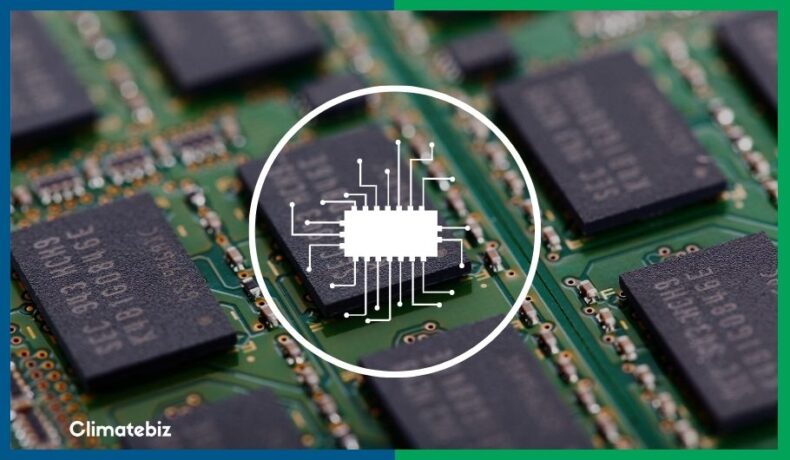
“What is a LiFePO4 BMS?”
Chances are you’ve read or heard the term BMS several times while learning about LiFePO4 batteries.
That’s because a BMS — which stands for Battery Management System — is a vital part of any Lithium-ion Battery.
While lithium-ion batteries — especially LiFePO4 batteries — are a popular choice for energy storage systems, they can be dangerous if not handled properly. That’s why it’s crucial to use the correct BMS in your battery pack.
This article will introduce you to LiFePO4 BMS and explain what they do. We’ll discuss how they work and how to choose the right LiFePO4 BMS for your battery.
Affiliate Disclaimer
Table of Contents
What Is A LiFePO4 BMS?
A BMS is an integral part of any lithium-ion battery system — it’s responsible for keeping the cells within the battery pack healthy and performing optimally.
Every battery has a specified range of voltage, current, and temperature in which it can safely operate. If one or more of these parameters varies considerably from their specified range, your battery pack can get permanently damaged (due to degradation of its components) and even pose safety risks.
Most batteries come with a built-in BMS to prevent this from happening.
But how does a BMS prevent you from damaging your battery pack?
A LiFePO4 BMS controls the discharge and charge processes of LiFePO4 battery packs. So if anything goes wrong during these processes, the BMS protection immediately kicks in and adjusts the charging parameters or cuts off the power flowing to and from the battery pack entirely.
Moreover, a BMS monitors the battery cells and makes sure they’re all working together correctly. It also measures parameters like voltage, current, and temperature to ensure that the battery is healthy and safe.
This way, a BMS helps prevent your battery from:
- Overcharge
- Overvoltage
- Overcurrent
- Overtemperature
- Cell Imbalance
- Shorter life cycle
Additionally, a BMS optimizes your battery capacity and overall performance in every charge/discharge process. This way, you can get the most out of your LiFePO4 battery pack regarding performance and lifespan.
LiFePO4 BMS Main Functions
1. Control operating conditions
Measures voltage, current, and temperature signals and controls these parameters to achieve cell balance and prevent damage to the battery.
2. Perform Diagnosis
Monitors cell-to-cell variations over time; diagnoses errors, detect safety risks, and sends warning signals to the driver (which can then initiate the proper measure to avoid this safety risk).
3. Collect and Store Data
Records the pack’s and the individual’s cell signals; stores data related to the battery’s life cycle history.
4. Estimate Parameters
Determines cell and pack levels such as State of Charge (SOC) and State of Health (SOH); communicates with controllers for cell balancing.
Types Of LiFePO4 BMS
You can find a LiFePO4 BMS in many different shapes and sizes, depending on the size of your LiFePO4 battery.
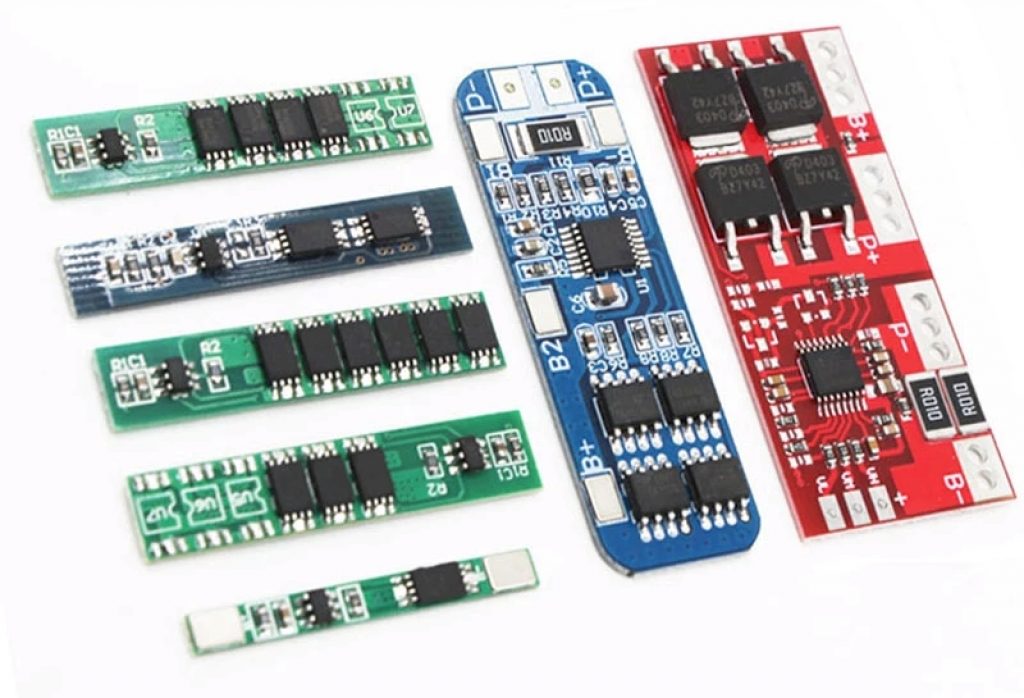
Some are simply the circuit board with all of the electronic components exposed:

Source: osmbattery.com
Conversely, some come in a case that protects the BMS from external conditions. They can be waterproof, dustproof and fire-resistant, etc.
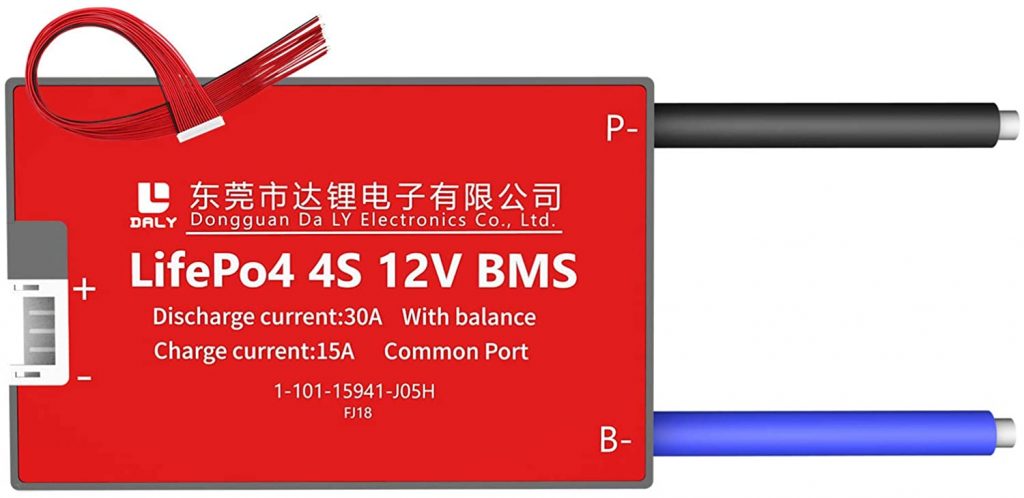
4S 12V means this BMS is for a 12V battery with 4 cells in series.
Source: amazon.com

Additionally, some options have a Bluetooth module so you can control and monitor your battery via an app on your phone.
How Does A LiFePO4 BMS Work?
A LiFePO4 BMS consists of several hardware and software functional blocks programmed with functions that protect the battery pack by monitoring and controlling its charge and discharge conditions.
A good BMS should offer protection against:
- Over and under-voltage
- Over and undercurrent
- Cell Imbalance
- Over and under temperature
Cut-off Voltage And Current
Battery management systems have current-driven and voltage-driven cut-off transistors that can cut off the power from the charger to the battery or from the battery to the load.
These transistors act as switches: when the cell voltage monitor detects a voltage higher than the system can handle, the switch is turned off, protecting the battery from overvoltage.
The same applies to Undervoltage: when the voltage monitor detects a voltage lower than the minimum charging or discharging voltage, the cut-off transistor kicks in, stopping this charging voltage from reaching the battery, thus avoiding any damage to the battery pack.
Cell Balancing
Another primary function of a LiFePO4 BMS is ensuring that all cells in a pack are correctly balanced.
Balanced cells mean that if you were to measure the voltage of each cell individually, you’d find the same value for every cell. This helps prevent the battery from charging/discharging erratically.
Here’s how a BMS balances a battery pack: by changing the charging current for one or more individual cells in the pack, making it different from the pack current, in one of the following ways:
- Removing charge from the cell charged the most provides “space” for additional charging current to prevent overcharging and allows the less charged cells to receive more charging current.
- Redirecting the charging current (partially or entirely) to the less charged cells, allowing them to receive a charging current for an extended period until cell balance is reached.
Temperature Control
A temperature sensor sends the battery’s temperature signal to the BMS’s monitoring unit. If a potentially dangerous charging or discharging temperature is detected, the BMS automatically cuts off any power to and from the battery, preventing any safety risks related to over or under temperature.
Many protection strategies are programmed into a BMS; most are too complex to mention. However, they all have the same goal: to protect the battery from any possible extreme conditions related to voltage, current, temperature, short circuit, cell imbalance, etc. Using a BMS, you can maximize battery life and performance.
Can I Charge A LiFePO4 Battery Without A BMS?
Yes, you can charge a LiFePO4 battery without a BMS. However, doing so can be dangerous, so this practice is not recommended.
Supplying a battery pack with a charging voltage or current higher than the recommended can lead to a thermal runaway, resulting in a fire or explosion.
To prevent serious safety issues from occurring, if you choose to charge your LiFePO4 battery (or any battery), you should at least closely monitor the charging conditions such as voltage, current, and temperature.
You can use voltage and amperage meters for this and a temperature sensor for your battery cells.
This way, you’ll know if your battery is under any stress and will be able to adjust the conditions accordingly.
In addition, by not using a BMS, you’ll negatively affect your battery’s service life. This way, it won’t last as long as it would if it had a BMS to ensure optimized working conditions.
How Do I Choose The Correct BMS For A LiFePO4 Battery?
While LiFePO4 batteries offer significant advantages, they can be pretty expensive. For this reason, you might be considering making your DIY LiFePO4.
If that’s the case, using the correct BMS for your LiFePO4 battery is crucial to ensuring your battery pack functions safely and correctly.
Choosing the correct LiFePO4 BMS greatly depends on the size of your battery system, in particular its rated voltage and capacity.
To better understand the requirements for choosing the correct BMS for your LiFePO4 battery pack, first review a few relevant battery properties like the voltage, amperage, capacity, and C-rating.
Voltage
Voltage is the electrical potential difference between two points in a circuit (the unit for voltage is volts, V).
In other words, voltage is the force/pressure in which the current moves through an electrical circuit.
A battery pack is an assembly of several cells. The number of cells (and their chemistry) in a battery pack will determine its nominal voltage.
Individual LiFePO4 cells have a nominal voltage of 3.2V. This way, connecting four LiFePO4 cells in series results in a battery pack with a 12.8V nominal voltage.
Amperage
Amperage is a measure of electrical current flow. It is sometimes referred to as Amps, for short. It expresses the number of electrons passing through a certain point in a circuit at a given time. In other words, it is the rate at which electrons flow in a circuit.
Battery Capacity
Battery capacity is measured in amp-hours (mAh for small-scale batteries). It indicates the total amount of current a battery can supply over 1 hour until its voltage drops to a specific value for each type of battery (cut-off voltage).
C-rate
The C-rate measures the discharge (or charge) rate of a battery relative to its rated capacity.
A 1C rate means that the discharge current would discharge the entire battery in 1 hour. Therefore, for a battery rated at 100Ah, 1C rate means that it would provide 100A for one hour. Conversely, if its C-rate were 0.5C, it would deliver 50A for two hours.
How Do You Size Your BMS?
Your battery’s correct LiFePO4 BMS size should be a BMS compatible with your LiFePO4 specs. For instance, if you have a 12V battery pack, it should use a BMS rated for 12V.
More importantly, is the BMS amperage rating. To correctly size your LiFePO4 BMS, you need to estimate the maximum power (in Watts) that you will be drawing from your battery. Here’s why:
This is how you calculate power:
Power (W) = Voltage (V) x Amperage (A)
Let’s say you want to build a solar system with a 2000W inverter to power loads of up to 1800W. You’re considering getting a 100A BMS to connect to your 12V LiFePO4 battery pack for this system.
Therefore, if you draw a 100A from your 12V battery (which is the most your 100A BMS can safely handle), the maximum power you’ll get from your system is 1200W.
Power (W) = 12V x 100A = 1200W
With this system, you won’t be able to power any load over this 1200W limit, and your 100A BMS won’t be compatible with the 2000W solar system you wish to build.
However, if you use a 200A BMS, the maximum power output of your system becomes 2400W:
Power (W) = 12V x 200A = 2400W
Now you have a compatible BMS to your 2000W system.
Conversely, if your battery pack’s nominal voltage is higher than 12V, you’ll be able to draw a larger amount of power using a 100A BMS:
For a 24V battery pack: Power (W) = 24V x 100A = 2400W max power output
For a 48V battery pack: Power (W) = 48V x 100A = 4800W max power output
However, this 100A BMS will have to be rated for the same voltage as your battery system.
Examples Of BMS From Overkill Solar:
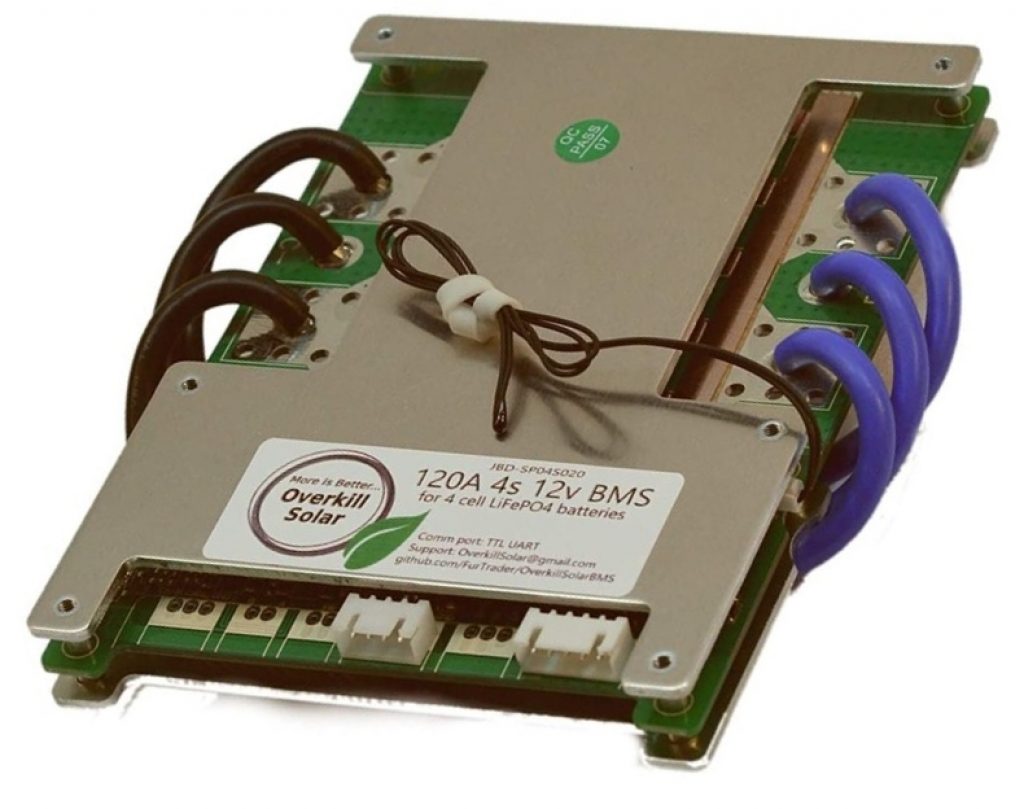
Source: mobile-solarpower.com
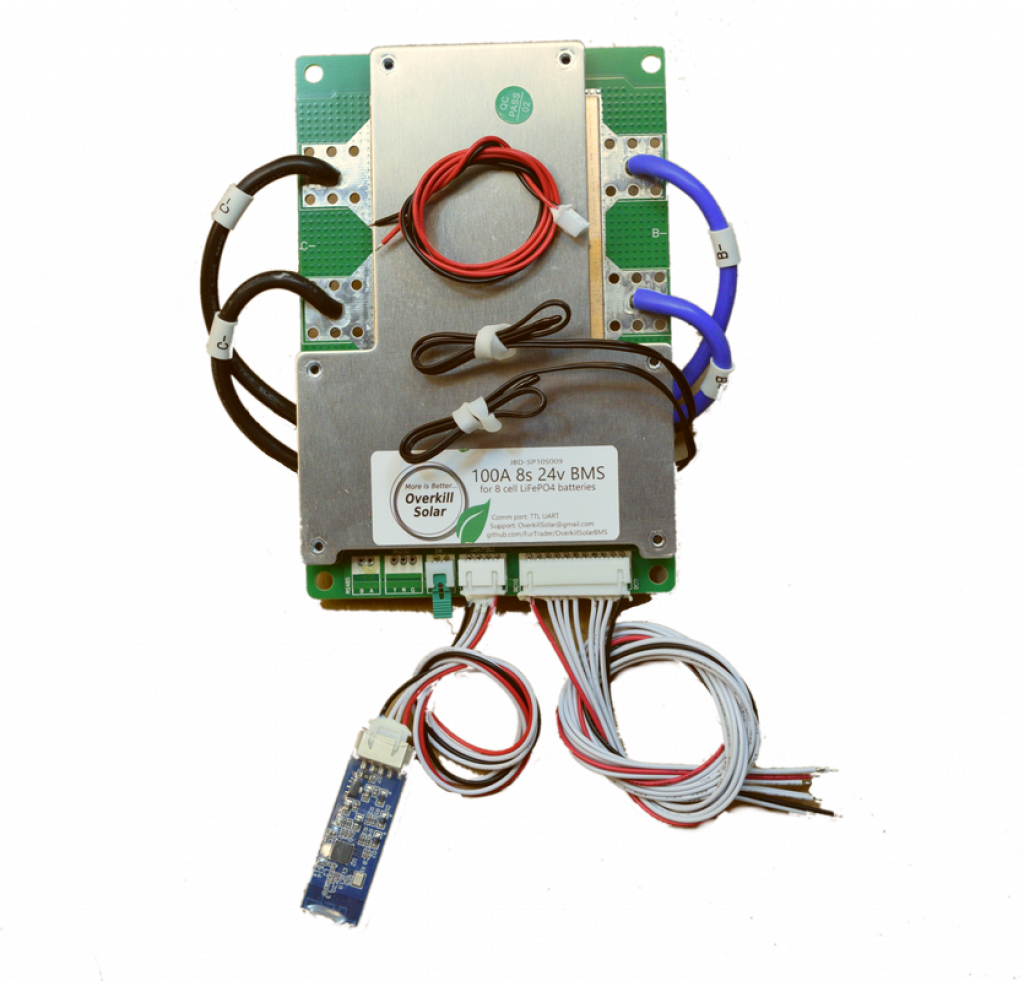
Source: mobile-solarpower.com
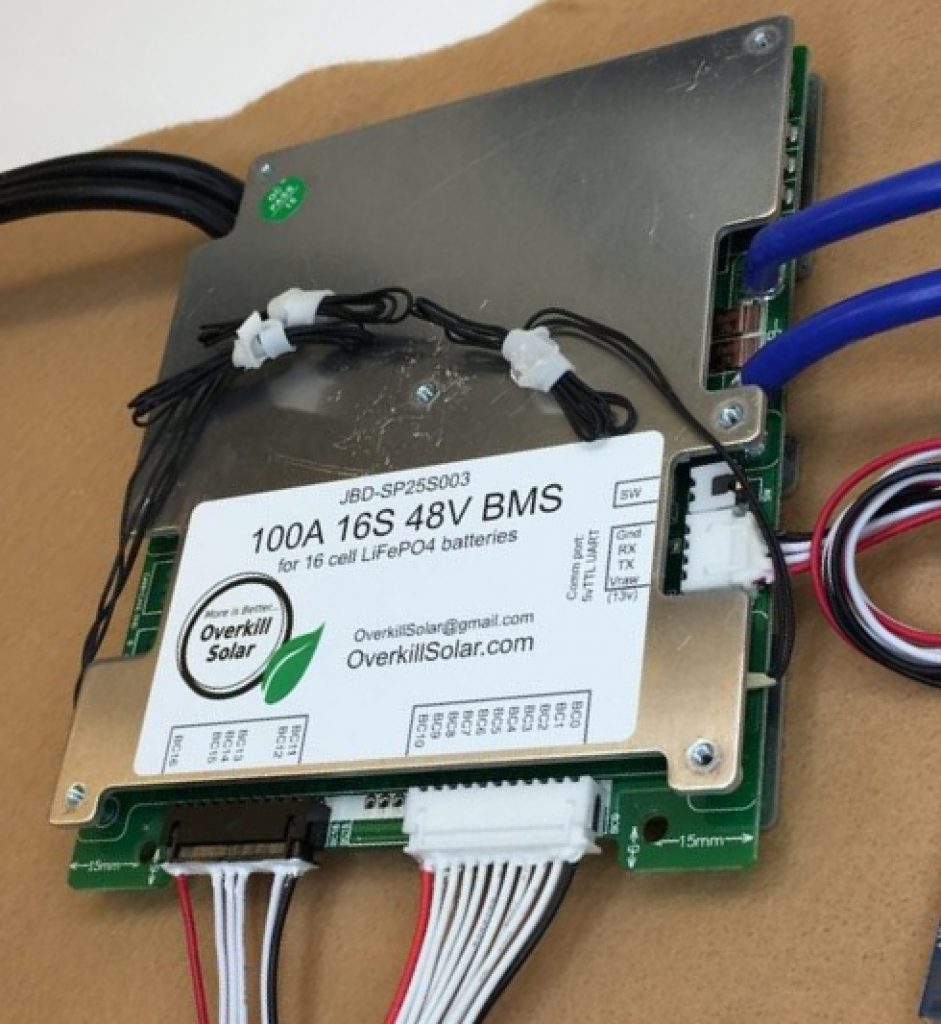
Source: mobile-solarpower.com
Another way of determining if a certain BMS will be able to handle your battery system is using the capacity and C-rate.
For example, if you have a battery pack with 200Ah of capacity and a maximum C-rate of 0.2C for a given load, then the BMS should be able to handle at least 40A because:
200Ah x 0.2C = 40A max, delivered for 5 hours
To summarize, choose a BMS with a continuous discharge current a bit larger than what you’ll be using your battery for and a charge current larger than you’ll be using to charge your battery. Always leave a bit of wiggle room for any unexpected situation.
In addition, make sure it is rated for your battery configuration: 4S for 4 cells (or packs of cells), 8S for 8 cells, 16S for 16 cells, etc. This is also reflected by the number of sampling wires that connect your BMS to your battery (there should be a wire for each cell). Here’s an image showing these sampling wires:
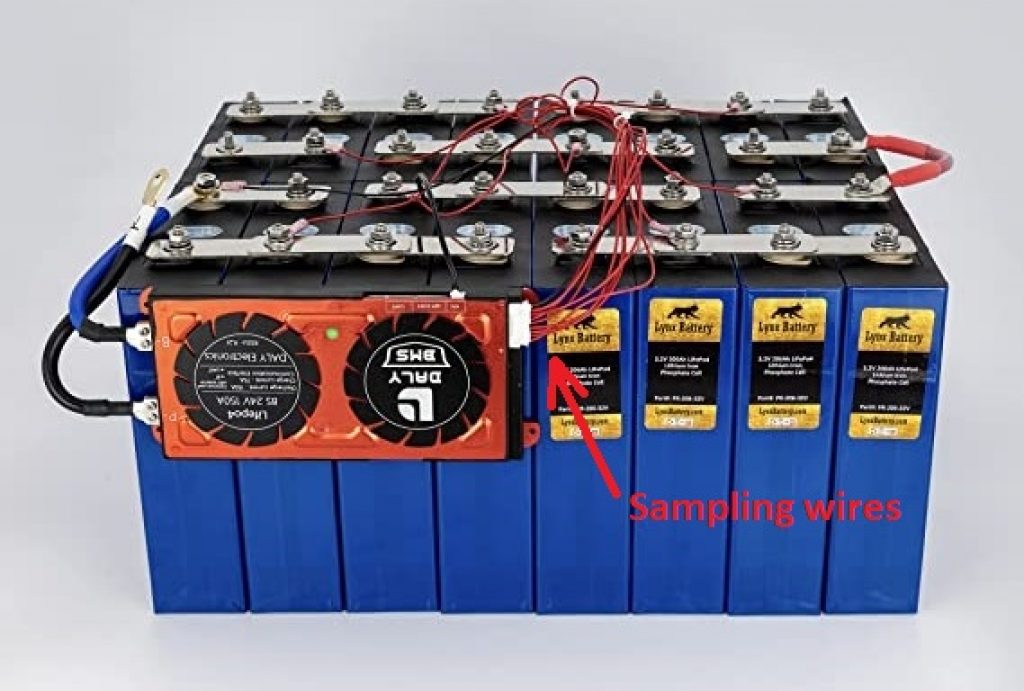
Source: adapted from amazon.com
Finally, make sure your LiFePO4 BMS comes with all the features you wish to have, like cell balancing, shockproof case, Bluetooth module to control and program via the app, etc.
Final Thoughts
The BMS is a crucial component of battery systems — it monitors the battery cells and makes sure they’re all functioning together properly within the battery pack.
It also measures charging and discharging parameters like voltage, current, and temperature to ensure that your battery is working correctly and safely.
If any of the cells start to malfunction, the BMS will take action to correct the problem, which may include shutting down the battery system entirely.
For this reason, choosing the correct BMS will significantly impact your battery pack’s life cycle and overall performance.









Thanks Ana for your good information’s and KIT please.
All good interesting detail. One fundamental point, Fe stands for ‘Iron’, on ‘Ion’
Hi Mark,
Thanks for you comment.
You’re right, the Fe in LiFePO4 stands for Iron. However, ‘Lithium Ion‘ refers to a type of rechargeable battery composed of cells in which lithium ions (ions are electrically charged atoms/ molecules) move between the electrodes. You can find Lithium Ion Batteries in several different chemistries. One of the most common chemistries of lithium ion batteries is the LiFePO4, in which one of the electrodes is made of lithium iron phosphate. Other examples of Lithium ion batteries are Lithium Cobalt Oxide (LiCoO2) and Lithium Nickel Manganese Cobalt Oxide (LiNiMnCoO2). If you’re interested in learning more about lithium ion batteries, here are two interesting articles:
Types of lithium ion
Lithium ion batteries
Please ignore my previous comment – I have done further checking and now stand corrected!
It was still interesting finding out the FE side of things. I just thought it was LIFE without any special meaning.
Thanks Ana. I am having trouble with a Chinese supplier, and may have to replace BMS’s on quite a few batteries. I set up a small business, and first few shipments went well, but everything has turned to custard. Not what a solo dad, small time farmer in New Zealand needs – thanks again
Hi James,
Thanks for the comment!
We’re sorry to hear that you’re having trouble with your supplier, but we hope your problems will be solved shortly. Good things take time!
Great article.
Could you please help to find a suitable BMS with bluetooth for this battery?
It has a BMS inside it but is is of poor quality
Hey Josh,
Thanks for reaching out to us!
You’re right, depending on your power needs, a 60A BMS can be small for a 200 Ah LiFePO4 battery.
With your current BMS, the maximum continuous discharge current is 60 A (0.3 C rate) before the short circuit protection kicks in and cuts off power, which is done to protect your battery.
However, LiFePO4 can be discharged at currents of up to 3C (although in most cases, a discharge current of up to 1C is recommended for prolonged use).
Therefore, if you’re planning on drawing more than 60A (768W) from your battery, or planning on charging it at a rate higher than 0.3C, then you’ll need a bigger BMS.
For your case, considering a discharge rate of up to 1C, a 200 A BMS would be recommended, such as the DALY Smart BMS 4S 12V 200A LiFePO4 or the RadioB Smart BMS 4S 12V 200A LiFePO4 BMS (both come with Bluetooth).
We hope this helps!
Here is the inside of the battery.
Any help is much appreciated.
Here is the BMS inside it. Someone said it is 60A and it is too small for this battery.
hi, Ana I am NEW (0 experience) on this solar panel system, am doing a project but I have something witch I trying to understand the project is for my basement to use some tool nothing heave 4×100 solar panel (parallel) solar charge controller mppt 60a Battery lifePO4 200AH w/ 200BMS, Renogy inverter 2000w when I connected the inverter looks like the inverter drain the battery and the inverter won’t work, contact Renogy and send the inverter to them they said inverter works fine and they suggest 100AH or 200AH but with100 BMS the question is what or were is my proble, the BMS battery cables? contact customer service from where I get my battery and they said should work fine,and found your page where you explain about the BMS can clarify please and decide contac you, any sugestions hope you can help me than you very much.
Hi. can anyone help me to find the ideal BMS for my 4s, 12.8v 120ah (4pcs of 3.2v 120ah). i am planning to install 30ah only since my load is 800watts only?
thanks